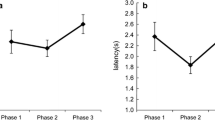Abstract
Domestic dogs comprehend human gestural communication flexibly, particularly the pointing gesture. Here, we examine whether dogs interpret pointing informatively, that is, as simply providing information, or rather as a command, for example, ordering them to move to a particular location. In the first study a human pointed toward an empty cup. In one manipulation, the dog either knew or did not know that the designated cup was empty (and that the other cup actually contained the food). In another manipulation, the human (as authority) either did or did not remain in the room after pointing. Dogs ignored the human’s gesture if they had better information, irrespective of the authority’s presence. In the second study, we varied the level of authority of the person pointing. Sometimes this person was an adult, and sometimes a young child. Dogs followed children’s pointing just as frequently as they followed adults’ pointing (and ignored the dishonest pointing of both), suggesting that the level of authority did not affect their behavior. Taken together these studies suggest that dogs do not see pointing as an imperative command ordering them to a particular location. It is still not totally clear, however, if they interpret it as informative or in some other way.



Similar content being viewed by others
References
Barth J, Reaux JE, Povinelli DJ (2005) Chimpanzees’ (Pan troglodytes) use of gaze cues in object-choice tasks: different methods yield different results. Anim Cogn 8:84–92
Bräuer J, Kaminski J, Riedel J, Call J, Tomasello M (2006) Making inferences about the location of hidden food: social dog, causal ape. J Comp Psychol 120:38–47
Call J, Bräuer J, Kaminski J, Tomasello M (2003) Domestic dogs (Canis familiaris) are sensitive to the attentional state of humans. J Comp Psychol 117:257–263
Carpenter M, Nagell K, Tomasello M (1998) Social cognition, joint attention, and communicative competence from 9 to 15 months of age. Monogr Soc Res Child Dev 63:1–143
Dorey NR, Udell MAR, Wynne CDL (2010) When do domestic dogs, Canis familiaris, start to understand human pointing? The role of ontogeny in the development of interspecies communication. Anim Behav 79:37–41
Elgier AM, Jakovcevic A, Barrera G, Mustaca AE, Bentosela M (2009) Communication between domestic dogs (Canis familiaris) and humans: dogs are good learners. Behav Process 81:402–408
Gácsi M, Miklósi Á, Varga O, Topál J, Csányi V (2004) Are readers of our face readers of our minds? Dogs (Canis familiaris) show situation-dependent recognition of human’s attention. Anim Cogn 7:144–153
Gácsi M, Gyoöri B, Virányi Z, Kubinyi E, Range F, Belényi B, Miklósi Á (2009) Explaining dog wolf differences in utilizing human pointing gestures: selection for synergistic shifts in the development of some social skills. PLoS ONE 4:e6584
Hare B, Tomasello M (2005) Human-like social skills in dogs? Trends Cognit Sci 9:439–444
Hare B, Brown M, Williamson C, Tomasello M (2002) The domestication of social cognition in dogs. Science 298:1634–1636
Kaminski J, Bräuer J, Call J, Tomasello M (2009) Domestic dogs are sensitive to a human’s perspective. Behaviour 146:979–998
Kaminski J, Schulz L, Tomasello M (2012) How dogs know when communication is intended for them. Dev Sci 15:222–232
Miklósi Á, Kubinyi E, Topál J, Gácsi M, Virányi Z, Csányi V (2003) A simple reason for a big difference: wolves do not look back at humans, but dogs do. Curr Biol 13:763–766
Povinelli DJ, Reaux JE, Bierschwale DT, Allain AD, Simon BB (1997) Exploitation of pointing as a referential gesture in young children, but not adolescent chimpanzees. Cognit Dev 12:327–365
Riedel J, Schumann K, Kaminski J, Call J, Tomasello M (2008) The early ontogeny of human-dog communication. Anim Behav 75:1003–1014
Scheider L, Grassmann S, Kaminski J, Tomasello M (2011) Domestic dogs use contextual information and tone of voice when following a human pointing gesture. PLoS ONE 6:e21676
Schwab C, Huber L (2006) Obey or not obey? Dogs (Canis familiaris) behave differently in response to attentional states of their owners. J Comp Psychol 120:169–175
Szetei V, Miklósi Á, Topál J, Csányi V (2003) When dogs seem to lose their nose: an investigation on the use of visual and olfactory cues in communicative context between dog and owner. Appl Anim Behav Sci 83:141–152
Tomasello M, Call J (1997) Primate cognition. Oxford University Press, New York, NY, USA
Topál J, Miklósi Á, Gácsi M, Dóka A, Pongrácz P, Kubinyi E, Virányi Z, Csányi V (2009) The dog as a model for understanding human social behavior. In: Brockmann HJ, Snowdon CT, Roper TJ, Naguib M, Wynne-Edwards KE (eds) Advances in the study of behavior, vol 39. Academic Press, London, pp 71–116
Udell MAR, Dorey NR, Wynne CDL (2008) Wolves outperform dogs in following human social cues. Anim Behav 76:1767–1773
Virányi Z, Gácsi M, Kubinyi E, Topál J, Belényi B, Ujfalussy D, Miklósi Á (2008) Comprehension of human pointing gestures in young human-reared wolve (canis lupus) and dogs (Canis familiaris). Anim Cogn 11:373–387
Wynne CDL, Udell MAR, Lord KA (2008) Ontogeny's impacts on human-dog communication. Anim Behav 76:e1–e4
Acknowledgments
We are especially grateful to the dog owners for their cooperation. We thank all students for their assistance during data collection and reliability coding, namely Susanne Mauritz, Katrin Schumann, Eileen Glabsch, Robina Thurmann, Marie Nitzschner, Lisa Heynig, Wiebke Bohnenberger, Juliane Pölchen, Peter Schuldt, Andrea Pitsch, Melanie Hartmann, Anne Hertel, Caroline Koegler, Kerstin Esau, and Bettina Müller. Juliane Kaminski was funded by a grant of the Volkswagenstiftung.
Author information
Authors and Affiliations
Corresponding author
Rights and permissions
About this article
Cite this article
Scheider, L., Kaminski, J., Call, J. et al. Do domestic dogs interpret pointing as a command?. Anim Cogn 16, 361–372 (2013). https://doi.org/10.1007/s10071-012-0577-8
Received:
Revised:
Accepted:
Published:
Issue Date:
DOI: https://doi.org/10.1007/s10071-012-0577-8




